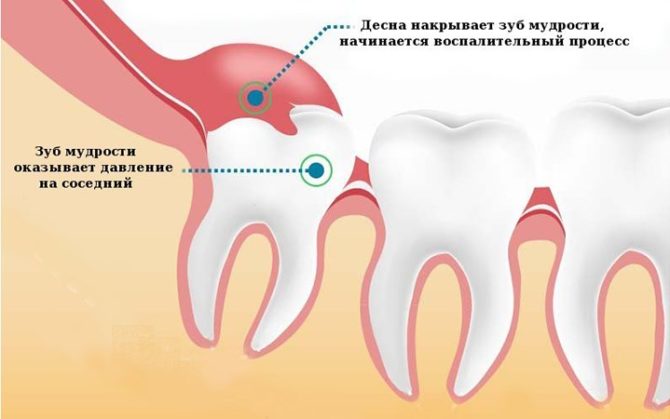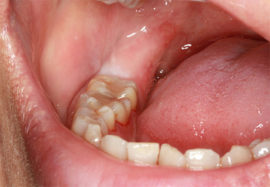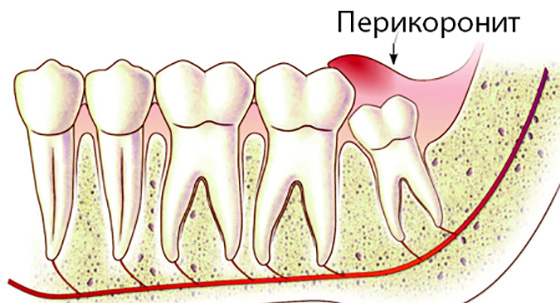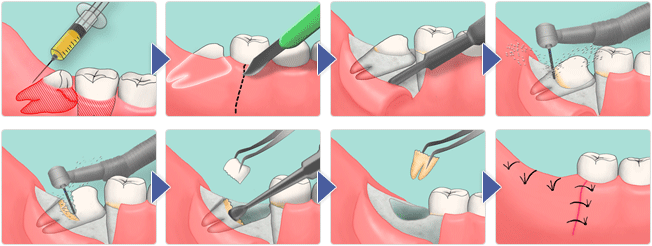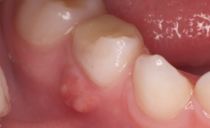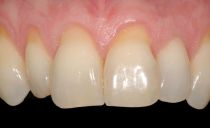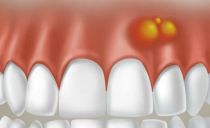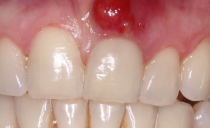A wisdom tooth grows and a gum aches: what is dangerous and how to treat
Problems with wisdom teeth are some of the most difficult in dentistry. If at the same time the wisdom tooth grows and the gums ache, then it is up to the specialist to decide what to do. You can not tolerate or alleviate symptoms at home - This is fraught with serious consequences.
Content
The specifics of teething wisdom
Dairy analogues at the end of the jaw in childhood do not grow, and soft tissues in adults are much more difficult to erupt. That is why, when the wisdom tooth climbs, the gums begin to hurt greatly. Another reason lies in the fact that with a narrow type of jaw there is limited space for full and proper growth.
A “wise” tooth often grows at an angle to the neighboring molar, which grew first, and has not yet appeared on the surface, injures it. It can also constantly touch the soft tissues of the gums or cheeks, which causes inflammation and pain.
Along with all of the above, third molars are more often than others prone to root curvature. therefore in the presence of any unpleasant symptoms, a visit to the dentist is necessary, since simply relieving pain when a wisdom tooth is cut is not enough - the problem will remain.
Even if the third molar got out normally, there is another problem: caries. It occurs due to problems with access to the place of accumulation of plaque during hygiene procedures. With the development of the disease, the gum does not bother, but the toothache increases, and the wisdom tooth is destroyed. Caries penetrates to the roots, and only then the surrounding soft tissues become inflamed.
It is rare that a third painter falls out on his own. Usually this occurs when it is completely destroyed, and only the upper part falls off. In this case, you should immediately go to the doctor, since the roots remain in the gum and become accessible to pathogenic organisms.
Causes of gum disease
A wisdom tooth climbs from under the gums very slowly, so for a long time there is a transformation of the mucous membrane (hood)under which pieces of food fall. Using standard hygiene procedures, they are very difficult to remove from there, but they themselves will not fall out. As a result, the process of multiplication of microorganisms begins, which causes inflammation. It can be seen by such manifestations:
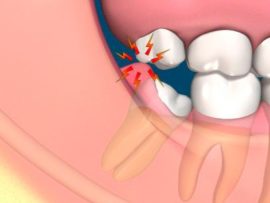 the area of inflammation turned red and swollen;
the area of inflammation turned red and swollen;- pain appears, sometimes throbbing;
- possibly a slight increase in temperature;
- there are blood and purulent discharge.
In the inflammatory process, it is not enough just to anesthetize the wisdom tooth, even if it hurts very slightly. To remove edema and tissue tension, it is necessary to perform a number of manipulations, and to do this qualitatively is possible only in the dental office. To do this, the doctor applies the following measures:
- cleaning the gingival pocket of food and foreign substances;
- lubrication of the area of inflammation with a gel with an anesthetic effect that makes you feel better when a wisdom tooth hurts;
- removal of the part of the hood that provokes pain and interferes with the eruption of a wisdom tooth;
- if necessary, the appointment of drug treatment;
- in severe cases - the appointment of an operation to remove a wisdom tooth.
Medical methods for pain relief
If, in the presence of signs of gum inflammation, it is not possible to immediately consult a doctor, then you can get rid of the pain in the area of the wisdom tooth at home. It is necessary to use anti-inflammatory drugs.
It is not recommended to endure severe pain when a wisdom tooth climbs. This has a bad effect on the general well-being of a person. You can take analgesics like analgin or, if they do not relieve pain, stronger substances, for example, Ketanov. Of local action, painkillers gels are used.
With swelling and redness of the gums, it is better to use complex preparations designed not only to relieve pain, but also have anti-inflammatory effect. These may be ibuprofen or nimesil based drugs. Reducing the intensity of inflammation can reduce the level of general intoxication of the body.
You also need to use antiseptics. Rinsing the oral cavity with solutions containing this type of medicine can reduce the number of harmful microbes and bacteria in the area of inflammation.
In the case of independent pre-medical drug treatment, it is necessary to keep records that will contain information about the type of drug, time of administration and dosage. These data must be provided to the dentist, as otherwise there may be a conflict between the active substances of the medicines taken at home with anesthetics.
Traditional medicine
 If the wisdom tooth does not hurt very much, then instead of pharmaceutical preparations you can rinse your mouth with decoctions of herbs to prevent the intensive development of the disease. Reduce the inflammatory process in the case of a teething tooth with the following decoctions and infusions:
If the wisdom tooth does not hurt very much, then instead of pharmaceutical preparations you can rinse your mouth with decoctions of herbs to prevent the intensive development of the disease. Reduce the inflammatory process in the case of a teething tooth with the following decoctions and infusions:
- oak bark has a healing and astringent effect;
- St. John's wort is a powerful antiseptic;
- chamomile is known as an antimicrobial and anti-inflammatory agent;
- mint and lemon balm have an anesthetic effect and facilitate the general condition;
- Salvia officinalis is a good antiseptic;
- salt solution with soda disinfects the entire oral cavity.
You can also use sea buckthorn oil. To do this, moisten a cotton wool in it and place a tampon next to the problem place. In the same way, you can use tincture of propolis or valerian.
You can relieve pain if the wisdom tooth hurts and there are no signs of inflammation, and you can also disinfect your mouth by rinsing it with vodka or other strong drinks. But if the gum is inflamed, then with this procedure there is a risk of getting a severe alcohol burn, which will complicate further treatment.
Even if at home I managed to get rid of puffiness and it didn’t hurt so much, anyway see a doctor as soon as possible to develop methods for further treatment. The sluggish process, when the wisdom tooth aches and becomes slightly inflamed, is a source of constant intoxication of the body, which is bad for internal organs. It is also fraught with overflowing into the pericoronitis of the acute phase.
Pericoronitis and periodontitis
The inflammatory process in the soft tissues around the outgoing tooth is referred to as pericoronitis. It is caused by a typical microflora of the oral cavity: anaerobic bacteria or staphylococci. They receive favorable conditions for development, since cleaning the plaque and food debris under the hood is difficult.
In addition to the gum swelling and aching wisdom tooth, the main symptoms of pericoronitis are as follows:
- pain in opening the mouth and swallowing;
- the pain intensifies when any object comes into contact with an inflamed hood;
- the pain can have a "shooting" character, gives in the ear or upper jaw;
- enlarged lymph nodes on the affected side;
- pus is released, bad breath appears.
If pericoronitis is not treated, then it can go into the chronic stage. Periodontitis of the wisdom tooth often becomes one of its complications.This disease is characterized by background aching pain and severe pain when biting. The tooth begins to swing a little, the gum swells more, and the inflammation of the surrounding tissues goes into a purulent stage.
Since it is not possible to anesthetize the wisdom tooth, which is cut with such accompanying factors, even the most fearful patients at this stage are forced to seek help. Although it was necessary to do this much earlier: when the tooth only got sick.
Indications for removing a wisdom tooth
If a wisdom tooth is cut and the gums hurt, delete it optional. With a little intervention, you can help the tooth get out. There are frequent cases when the third molar cuts seamlessly and functions until old age, and then it is also used when installing bridges.
Significant reasons for removing a wisdom tooth, even if it does not hurt, are growth anomalies. The doctor will prescribe the procedure if the molar:
- erupts in the direction of the cheek and constantly injures it;
- erupts in the direction of the second molar, which causes its deformation or displacement of the entire dentition.
You will also have to resort to removal in the following cases:
- the presence of caries and the difficulties encountered with its treatment;
- the presence of a cyst in the root zone;
- inflammation of the roots in the upper jaw with the development of sinusitis;
- the presence of purulent inflammation, which is difficult to treat, since the tooth interferes with this.
In case of suspicion of improper location, an x-ray photo is taken. With it, the dentist will work out the optimal sequence of actions during the operation. Anomalies of the position of the roots, which cannot be determined otherwise, will also be visible in the photo. X-ray images of the jaw are safe and saved many patients from problems with the removal of irregularly located teeth.
Removal process
Before the operation, the doctor needs to anesthetize the place where the surgery will be performed. Therefore, if the patient at home took some pain medication to eliminate the inflammation near the wisdom tooth, then the doctor must be informed about this.
When removing the third molars of the upper and lower jaw, there is a specificity. The roots of the upper teeth can go into the maxillary sinus, therefore, almost always an x-ray is taken to determine their position. But on the lower jaw, “wise” teeth hold on to bone tissue much more tightly, and much stronger physical efforts will be required to extract them.
The surgical procedure itself includes the following steps:
- cut and remove part of the gum, which may interfere with extraction, if the object has not fully come out;
- rock the tooth to lose traction with bone tissue;
- the tooth is pulled and cleaned;
- clean the resulting hole.
At the end of the removal procedure, the doctor may suture the well. With complex root geometry, the tooth comes out difficult, so it can be cut and removed in parts. In this case, the operation itself (excluding the time for anesthesia) can take 20-40 minutes.
Postoperative measures
If a wisdom tooth was removed, then in the postoperative period it is necessary to perform all the activities prescribed by the dentist. Usually he prescribes painkillers, less often anti-inflammatory drugs. Their intake is limited to 2-3 days.
During this period, pain, a slight fever, and chills are possible. Therefore, it’s better not to plan important things and Never catch or warm the operation site.. Do not examine the wound yourself or disturb it with your tongue.
Immediately after removal, it will be painful to eat solid and hot food, a slight swelling of the face is possible. For some time, blood will come out of the hole. If after three days there is no relief, the symptoms of inflammation remain, then you must again see a doctor.
Gum disease and pain with improper growth of a wisdom tooth is a very common condition.The sooner the patient seeks qualified help, the easier and faster the healing process will be.
Even if, as a result of the examination, a decision is made to remove the wisdom tooth, then you should not be afraid of it - the possibilities of modern medicine have grown and allow you to perform this procedure almost painlessly. If you endure pain for a long time and take only self-medication measures, then there is a high probability of serious complications that may affect not only the jaw zone.


